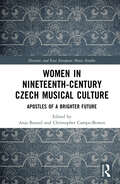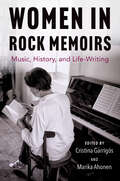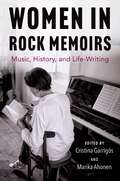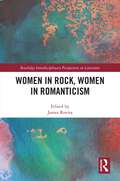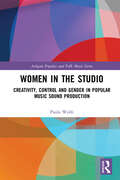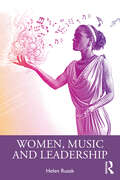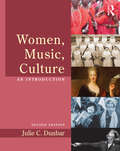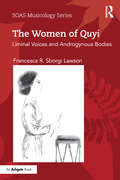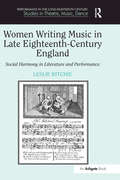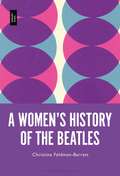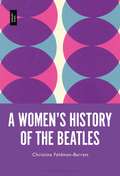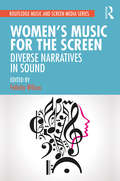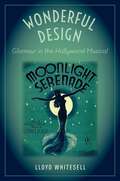- Table View
- List View
Women in Nineteenth-Century Czech Musical Culture: Apostles of a Brighter Future (Slavonic and East European Music Studies)
by Anja Bunzel Christopher Campo-BowenThis volume focuses on the circumstances of women’s music-making in the vibrant and diverse environment of the Czech lands during the nineteenth century. It sheds light on little-known women musicians, while also considering more well-known works and composers from new woman-centric perspectives. It shows how the unique environment of Habsburg Central Europe, especially Bohemia and Lower Austria, intersects with gender to reveal hitherto unexplored networks that challenge the methodological nationalism of music studies as well as the discipline’s continued emphasis on singular canonical figures. The main areas of enquiry address aspects of performance and identity both within the Czech lands and abroad; women’s impact on social life with a view to different private, semiprivate, and public contexts and networks; and compositional aesthetics in musical works by and about women, analysed through the lens of piano works, song, choir music, and opera, always with the reception of these works in mind.
Women in Rock Memoirs: Music, History, and Life-Writing
by Cristina Garrigós and Marika AhonenWomen in Rock Memoirs vindicates the role of women in rock music. The chapters examine memoirs written by women in rock from 2010 onwards to explore how the artists narrate their life experiences and difficulties they had to overcome, not only as musicians but as women. The book includes memoirs written by both well-known and lesser-known artists and artists from both inside and outside of the Anglo-American sphere. The essays by scholars from different research areas and countries around the world are divided into three parts according to the overall themes: Memory, Trauma, and Writing; Authenticity, Sexuality, and Sexism; and Aging, Performance, and the Image. They explore the dynamics of memoir as a genre by discussing the similarities and differences between the women in rock and the choices they have made when writing their books. As a whole, they help form a better understanding of today's possibilities and future challenges for women in rock music.
Women in Rock Memoirs: Music, History, and Life-Writing
Women in Rock Memoirs vindicates the role of women in rock music. The chapters examine memoirs written by women in rock from 2010 onwards to explore how the artists narrate their life experiences and difficulties they had to overcome, not only as musicians but as women. The book includes memoirs written by both well-known and lesser-known artists and artists from both inside and outside of the Anglo-American sphere. The essays by scholars from different research areas and countries around the world are divided into three parts according to the overall themes: Memory, Trauma, and Writing; Authenticity, Sexuality, and Sexism; and Aging, Performance, and the Image. They explore the dynamics of memoir as a genre by discussing the similarities and differences between the women in rock and the choices they have made when writing their books. As a whole, they help form a better understanding of today's possibilities and future challenges for women in rock music.
Women in Rock, Women in Romanticism (Routledge Interdisciplinary Perspectives on Literature)
by Rovira JamesWomen in Rock, Women in Romanticism is the first book-length work to explore the interrelationships between contemporary female musicians and eighteenth- and nineteenth-century art, music, and literature by women and men. The music and videos of contemporary musicians including Erykah Badu, Beyoncé, The Carters, Hélène Cixous, Missy Elliot, the Indigo Girls, Janet Jackson, Janis Joplin (and Big Brother and the Holding Company), Natalie Merchant, Joni Mitchell, Janelle Monáe, Alanis Morrisette, Siouxsie Sioux, Patti Smith, St. Vincent (Annie Clark), and Alice Walker are explored through the lenses of pastoral and Afropresentism, Gothic, female Gothic, and the literature of William Blake, Beethoven, Arthur Schopenhauer, Samuel Taylor Coleridge, Charlotte Dacre, Ralph Waldo Emerson, E.T.A. Hoffmann, Ann Radcliffe, William Shakespeare, Mary Shelley, her husband Percy Shelley, Henry David Thoreau, Horace Walpole, Jane Williams, Mary Wollstonecraft, and William Wordsworth to explore how each sheds light on the other, and how women have appropriated, responded to, and been inspired by the work of authors from previous centuries.
Women in Rock, Women in Romanticism (Routledge Interdisciplinary Perspectives on Literature)
by James RoviraWomen in Rock, Women in Romanticism is the first book-length work to explore the interrelationships between contemporary female musicians and eighteenth- and nineteenth-century art, music, and literature by women and men. The music and videos of contemporary musicians including Erykah Badu, Beyoncé, The Carters, Hélène Cixous, Missy Elliot, the Indigo Girls, Janet Jackson, Janis Joplin (and Big Brother and the Holding Company), Natalie Merchant, Joni Mitchell, Janelle Monáe, Alanis Morrisette, Siouxsie Sioux, Patti Smith, St. Vincent (Annie Clark), and Alice Walker are explored through the lenses of pastoral and Afropresentism, Gothic, female Gothic, and the literature of William Blake, Beethoven, Arthur Schopenhauer, Samuel Taylor Coleridge, Charlotte Dacre, Ralph Waldo Emerson, E.T.A. Hoffmann, Ann Radcliffe, William Shakespeare, Mary Shelley, her husband Percy Shelley, Henry David Thoreau, Horace Walpole, Jane Williams, Mary Wollstonecraft, and William Wordsworth to explore how each sheds light on the other, and how women have appropriated, responded to, and been inspired by the work of authors from previous centuries.
Women in the Studio: Creativity, Control and Gender in Popular Music Sound Production (Ashgate Popular and Folk Music Series)
by Paula WolfeThe field of popular music production is overwhelmingly male dominated. Here, Paula Wolfe discusses gendered notions of creativity and examines the significant under-representation of women in studio production. Wolfe brings an invaluable perspective as both a working artist-producer and as a scholar, thereby offering a new body of research based on interviews and first-hand observation. Wolfe demonstrates that patriarchal frameworks continue to form the backbone of the music industry establishment but that women’s work in the creation and control of sound presents a potent challenge to gender stereotyping, marginalisation and containment of women’s achievements that is still in evidence in music marketing practices and media representation in the digital era.
Women in the Studio; Creativity, Control and Gender in Popular Music Production: Creation, Control And Gender In Popular Music Sound Production (Ashgate Popular And Folk Music Ser.)
by Paula WolfeThe field of popular music production is overwhelmingly male dominated. Here, Paula Wolfe discusses gendered notions of creativity and examines the significant under-representation of women in studio production. Wolfe brings an invaluable perspective as both a working artist-producer and as a scholar, thereby offering a new body of research based on interviews and first-hand observation. Wolfe demonstrates that patriarchal frameworks continue to form the backbone of the music industry establishment but that women’s work in the creation and control of sound presents a potent challenge to gender stereotyping, marginalisation and containment of women’s achievements that is still in evidence in music marketing practices and media representation in the digital era.
Women in Vinyl: The Art of Making Vinyl
by Jenn D’EugenioWomen in Vinyl: The Art of Making Vinyl provides a comprehensive guide to the world of vinyl, with a focus on empowerment, diversity, and inclusion, designed to both demystify the vinyl community and highlight the vital role women and minority groups play in shaping the industry.Divided into each step of the process, the book provides a detailed overview of the vinyl manufacturing process, from lacquer cutting, electroplating, and record pressing, to the roles of record labels, distribution, DJs, and more. With interviews and profiles from global professionals throughout, the book is a first-of-its-kind guide to the vinyl industry and the women who are blazing trails within it. Women in Vinyl is an essential resource for professionals, hobbyists, and students interested in the process of making vinyl, including those who want to deepen their understanding of the vinyl medium and its role in shaping the music industry, as well as for those interested in the work of the organization Women in Vinyl.
Women in Vinyl: The Art of Making Vinyl
by Jenn D’EugenioWomen in Vinyl: The Art of Making Vinyl provides a comprehensive guide to the world of vinyl, with a focus on empowerment, diversity, and inclusion, designed to both demystify the vinyl community and highlight the vital role women and minority groups play in shaping the industry.Divided into each step of the process, the book provides a detailed overview of the vinyl manufacturing process, from lacquer cutting, electroplating, and record pressing, to the roles of record labels, distribution, DJs, and more. With interviews and profiles from global professionals throughout, the book is a first-of-its-kind guide to the vinyl industry and the women who are blazing trails within it. Women in Vinyl is an essential resource for professionals, hobbyists, and students interested in the process of making vinyl, including those who want to deepen their understanding of the vinyl medium and its role in shaping the music industry, as well as for those interested in the work of the organization Women in Vinyl.
Women, Music and Leadership
by Helen RusakWomen, Music and Leadership offers a wide-ranging survey of women in musical leadership and their experiences, highlighting women’s achievements and considering how they negotiate the challenges of the leadership space in music. Women have always participated in music as performers, teachers, composers and professionals, but remain underrepresented in leadership positions. Covering women’s leadership across a wide variety of roles and musical genres, this book addresses women in classical music, gospel, blues, jazz, popular music, electronic music and non-Western musical contexts, and considers women working as composers, as conductors, and in music management and the music business. Each chapter includes several case studies of women’s careers, exploring their groundbreaking contributions to music and the challenges they faced as leaders. Connecting management theory and leadership research with feminist musicology, this book paints a new picture of women’s major contributions as leaders in music and their ongoing struggles for equity. It will be relevant to students and scholars in arts and music management, as well as all those studying music, gender or leadership, and women music professionals.
Women, Music and Leadership
by Helen RusakWomen, Music and Leadership offers a wide-ranging survey of women in musical leadership and their experiences, highlighting women’s achievements and considering how they negotiate the challenges of the leadership space in music. Women have always participated in music as performers, teachers, composers and professionals, but remain underrepresented in leadership positions. Covering women’s leadership across a wide variety of roles and musical genres, this book addresses women in classical music, gospel, blues, jazz, popular music, electronic music and non-Western musical contexts, and considers women working as composers, as conductors, and in music management and the music business. Each chapter includes several case studies of women’s careers, exploring their groundbreaking contributions to music and the challenges they faced as leaders. Connecting management theory and leadership research with feminist musicology, this book paints a new picture of women’s major contributions as leaders in music and their ongoing struggles for equity. It will be relevant to students and scholars in arts and music management, as well as all those studying music, gender or leadership, and women music professionals.
Women, Music, Culture: An Introduction
by Julie C. DunbarWomen, Music, Culture: An Introduction, Second Edition is the first undergraduate textbook on the history and contribution of women in a variety of musical genres and professions, ideal for students in courses in both music and women's studies. A compelling narrative, accompanied by over 50 guided listening examples, brings the world of women in music to life, examining a community of female musicians, including composers, producers, consumers, performers, technicians, mothers, and educators in art music and popular music. The book features a wide array of pedagogical aids, including a running glossary and a comprehensive companion website with streamed audio tracks, that help to reinforce key figures and terms. This new edition includes a major revision of the Women in World Music chapter, a new chapter in Western Classical "Work" in the Enlightenment, and a revised chapter on 19th Century Romanticism: Parlor Songs to Opera. 20th Century Art Music.
Women, Music, Culture: An Introduction
by Julie C. DunbarWomen, Music, Culture: An Introduction, Second Edition is the first undergraduate textbook on the history and contribution of women in a variety of musical genres and professions, ideal for students in courses in both music and women's studies. A compelling narrative, accompanied by over 50 guided listening examples, brings the world of women in music to life, examining a community of female musicians, including composers, producers, consumers, performers, technicians, mothers, and educators in art music and popular music. The book features a wide array of pedagogical aids, including a running glossary and a comprehensive companion website with streamed audio tracks, that help to reinforce key figures and terms. This new edition includes a major revision of the Women in World Music chapter, a new chapter in Western Classical "Work" in the Enlightenment, and a revised chapter on 19th Century Romanticism: Parlor Songs to Opera. 20th Century Art Music.
The Women of Quyi: Liminal Voices and Androgynous Bodies (SOAS Studies in Music)
by Francesca R. Sborgi LawsonWhy has the female voice—as the resonant incarnation of the female body—inspired both fascination and ambivalence? Why were women restricted from performing on the Chinese public stage? How have female roles and voices been appropriated by men throughout much of the history of Chinese theatre? Why were the women of quyi—a community of Chinese female singers in Republican Tianjin—able to become successful, respected artists when other female singers and actors in competing performance traditions struggled for acceptance? Drawing substantially on original ethnographic fieldwork conducted in the 1980s and 1990s, Francesca R. Sborgi Lawson offers answers to these questions and demonstrates how the women of quyi successfully negotiated their sexuality and vocality in performance. Owing to their role as third-person narrators, the women of quyi bridged the gender gap, creating an androgynous persona that de-emphasized their feminine appearance and, at the same time, allowed them to showcase their female voices on public stages—places that had been previously unwelcoming to female artists. This is a story about female storytellers who sang their way to respectability and social change in the early decades of the twentieth century by minimizing their bodies in order to allow their voices to be heard.
The Women of Quyi: Liminal Voices and Androgynous Bodies (SOAS Studies in Music)
by Francesca R. Sborgi LawsonWhy has the female voice—as the resonant incarnation of the female body—inspired both fascination and ambivalence? Why were women restricted from performing on the Chinese public stage? How have female roles and voices been appropriated by men throughout much of the history of Chinese theatre? Why were the women of quyi—a community of Chinese female singers in Republican Tianjin—able to become successful, respected artists when other female singers and actors in competing performance traditions struggled for acceptance? Drawing substantially on original ethnographic fieldwork conducted in the 1980s and 1990s, Francesca R. Sborgi Lawson offers answers to these questions and demonstrates how the women of quyi successfully negotiated their sexuality and vocality in performance. Owing to their role as third-person narrators, the women of quyi bridged the gender gap, creating an androgynous persona that de-emphasized their feminine appearance and, at the same time, allowed them to showcase their female voices on public stages—places that had been previously unwelcoming to female artists. This is a story about female storytellers who sang their way to respectability and social change in the early decades of the twentieth century by minimizing their bodies in order to allow their voices to be heard.
Women Who Rock: Bessie to Beyonce. Girl Groups to Riot Grrrl.
by Evelyn McDonnellA stellar and unprecedented celebration of 104 musical artists, Women Who Rock is the most complete, up-to-date history of the evolution, influence, and importance of women in music. A gorgeous gift book, it includes a stunning, specially commissioned, full-color illustrated portrait of every musician and group. From Bessie Smith and The Supremes to Joan Baez, Madonna, BeyoncéAmy Winehouse, Dolly Parton, Sleater-Kinney, Taylor Swift, and scores more, women have played an essential and undeniable role in the evolution of popular music including blues, rock and roll, country, folk, glam rock, punk, and hip hop. Today, in a world traditionally dominated by male artists, women have a stronger influence on popular music than ever before. Yet, not since the late nineteen-nineties has there been a major work that acknowledges and pays tribute to the female artists who have contributed to, defined, and continue to make inroads in music. In Women Who Rock, writer and professor of journalism Evelyn McDonnell leads a team of women rock writers and pundits in an all-out celebration of 104 of the greatest female musicians. Organized chronologically, the book profiles each artist and places her in the context of both her genre and the musical world at large. Sidebars throughout recall key moments that shaped both the trajectory of music and how those moments influenced or were influenced by women artists. With full-color illustrated portraits by women artists, Women Who Rock will be THE long-awaited gift book for every music fan, feminist, and female rocker, young and old musicians.
Women Writing Music in Late Eighteenth-Century England: Social Harmony in Literature and Performance (Performance In The Long Eighteenth Century: Studies In Theatre, Music, Dance Ser.)
by Leslie RitchieCombining new musicology trends, formal musical analysis, and literary feminist recovery work, Leslie Ritchie examines rare poetic, didactic, fictional, and musical texts written by women in late eighteenth-century Britain. She finds instances of and resistance to contemporary perceptions of music as a form of social control in works by Maria Barth mon, Harriett Abrams, Mary Worgan, Susanna Rowson, Hannah Cowley, and Amelia Opie, among others. Relating women's musical compositions and writings about music to theories of music's function in the formation of female subjectivities during the latter half of the eighteenth century, Ritchie draws on the work of cultural theorists and cultural historians, as well as feminist scholars who have explored the connection between femininity and performance. Whether crafting works consonant with societal ideals of charitable, natural, and national order, or re-imagining their participation in these musical aids to social harmony, women contributed significantly to the formation of British cultural identity. Ritchie's interdisciplinary book will interest scholars working in a range of fields, including gender studies, musicology, eighteenth-century British literature, and cultural studies.
Women Writing Music in Late Eighteenth-Century England: Social Harmony in Literature and Performance
by Leslie RitchieCombining new musicology trends, formal musical analysis, and literary feminist recovery work, Leslie Ritchie examines rare poetic, didactic, fictional, and musical texts written by women in late eighteenth-century Britain. She finds instances of and resistance to contemporary perceptions of music as a form of social control in works by Maria Barth mon, Harriett Abrams, Mary Worgan, Susanna Rowson, Hannah Cowley, and Amelia Opie, among others. Relating women's musical compositions and writings about music to theories of music's function in the formation of female subjectivities during the latter half of the eighteenth century, Ritchie draws on the work of cultural theorists and cultural historians, as well as feminist scholars who have explored the connection between femininity and performance. Whether crafting works consonant with societal ideals of charitable, natural, and national order, or re-imagining their participation in these musical aids to social harmony, women contributed significantly to the formation of British cultural identity. Ritchie's interdisciplinary book will interest scholars working in a range of fields, including gender studies, musicology, eighteenth-century British literature, and cultural studies.
A Women’s History of the Beatles
by Christine Feldman-BarrettA Women's History of the Beatles is the first book to offer a detailed presentation of the band's social and cultural impact as understood through the experiences and lives of women. Drawing on a mix of interviews, archival research, textual analysis, and autoethnography, this scholarly work depicts how the Beatles have profoundly shaped and enriched the lives of women, while also reexamining key, influential female figures within the group's history. Organized topically based on key themes important to the Beatles story, each chapter uncovers the varied and multifaceted relationships women have had with the band, whether face-to-face and intimately or parasocially through mediated, popular culture. Set within a socio-historical context that charts changing gender norms since the early 1960s, these narratives consider how the Beatles have affected women's lives across three generations. Providing a fresh perspective of a well-known tale, this is a cultural history that moves far beyond the screams of Beatlemania to offer a more comprehensive understanding of what the now iconic band has meant to women over the course of six decades.
A Women’s History of the Beatles
by Christine Feldman-BarrettA Women's History of the Beatles is the first book to offer a detailed presentation of the band's social and cultural impact as understood through the experiences and lives of women. Drawing on a mix of interviews, archival research, textual analysis, and autoethnography, this scholarly work depicts how the Beatles have profoundly shaped and enriched the lives of women, while also reexamining key, influential female figures within the group's history. Organized topically based on key themes important to the Beatles story, each chapter uncovers the varied and multifaceted relationships women have had with the band, whether face-to-face and intimately or parasocially through mediated, popular culture. Set within a socio-historical context that charts changing gender norms since the early 1960s, these narratives consider how the Beatles have affected women's lives across three generations. Providing a fresh perspective of a well-known tale, this is a cultural history that moves far beyond the screams of Beatlemania to offer a more comprehensive understanding of what the now iconic band has meant to women over the course of six decades.
Women's Leadership in Music: Modes, Legacies, Alliances (Musik und Klangkultur #63)
by Iva Nenic Linda CimardiVarious modes of women's contemporary cultural, social and political leadership can be found in music. Informed by different histories and culturally bound social mores but also by a comparative perspective, the contributors of this volume ask what can be considered leadership in culture from women's point of view. They deconstruct the notion of leadership as corporative and career-related modes of success by showing how women's agency, power and negotiation in and through music can and should be considered as empowering, transformative and role-modeling. By interweaving several disciplinary perspectives - from ethnomusicology, musicology and cultural management to sociology and anthropology - this volume aims to substantially contribute to the study of women's leadership.
Women's Music for the Screen: Diverse Narratives in Sound
by Felicity WilcoxWomen’s Music for the Screen: Diverse Narratives in Sound shines a long-overdue light on the works and lives of female-identifying screen composers. Bringing together composer profiles, exclusive interview excerpts, and industry case studies, this volume showcases their achievements and reflects on the systemic gender biases women have faced in an industry that has long excluded them. Across 16 essays, an international array of contributors present a wealth of research data, biographical content, and musical analysis of film, television, and video game scores to understand how the industry excludes women, the consequences of these deficits, and why such inequities persist – and to document women’s rich contributions to screen music in diverse styles and genres.The chapters amplify the voices of women composers including Bebe Barron, Delia Derbyshire, Wendy Carlos, Anne Dudley, Rachel Portman, Hildur Guðnadóttir, Mica Levi, Winifred Phillips, and more. From the mid-twentieth century to the present, and from classic Hollywood scores to pioneering electronic music, these are the stories and achievements of the women who have managed to forge successful careers in a male-dominated arena. Suitable for researchers, educators, and students alike, Women’s Music for the Screen urges the screen music industry to consider these sounds and stories in a way it hasn’t before: as voices that more accurately reflect the world we all share.
Women's Music for the Screen: Diverse Narratives in Sound
by Felicity WilcoxWomen’s Music for the Screen: Diverse Narratives in Sound shines a long-overdue light on the works and lives of female-identifying screen composers. Bringing together composer profiles, exclusive interview excerpts, and industry case studies, this volume showcases their achievements and reflects on the systemic gender biases women have faced in an industry that has long excluded them. Across 16 essays, an international array of contributors present a wealth of research data, biographical content, and musical analysis of film, television, and video game scores to understand how the industry excludes women, the consequences of these deficits, and why such inequities persist – and to document women’s rich contributions to screen music in diverse styles and genres.The chapters amplify the voices of women composers including Bebe Barron, Delia Derbyshire, Wendy Carlos, Anne Dudley, Rachel Portman, Hildur Guðnadóttir, Mica Levi, Winifred Phillips, and more. From the mid-twentieth century to the present, and from classic Hollywood scores to pioneering electronic music, these are the stories and achievements of the women who have managed to forge successful careers in a male-dominated arena. Suitable for researchers, educators, and students alike, Women’s Music for the Screen urges the screen music industry to consider these sounds and stories in a way it hasn’t before: as voices that more accurately reflect the world we all share.
Wonderful Design: Glamour in the Hollywood Musical
by Lloyd WhitesellAs one of the most beloved and beguiling genres of entertainment, the film musical wears its style ostentatiously. The genre allows for hyperbolic expression, extravagant sonic and visual decor, and extremely stylized forms of movement and performance. By staging a glittering spectacle, by releasing a current of lush sentiment, by unveiling a world of elegance and romance, the film musical woos us with patterns, textures, finesse and sensory display. In this book, author Lloyd Whitesell asks what, exactly, makes film musicals so glamorous. As he argues, glamour projects an aura of ethereality or sophistication by way of suave deportment, sensuous textures, elevated styles, and aesthetically refined effects. Glamour, in other words, is what unites "Cheek to Cheek" from Top Hat and the title song from Beauty and the Beast, each a sonic evocation of luxury, sparkle, grace, and finesse. Whitesell redirects our attention from visual cues like sequins and evening gloves to explore how glamour resides in the sonic. Discussing dozens of musical numbers, analyzing ingenious orchestration, and appraising the distinctive styles of favorite musical stars, Whitesell illuminates fundamental traits of the genre, its aesthetic strategies, and cultural ambitions.
WONDERFUL DESIGN C: Glamour in the Hollywood Musical
by Lloyd WhitesellAs one of the most beloved and beguiling genres of entertainment, the film musical wears its style ostentatiously. The genre allows for hyperbolic expression, extravagant sonic and visual decor, and extremely stylized forms of movement and performance. By staging a glittering spectacle, by releasing a current of lush sentiment, by unveiling a world of elegance and romance, the film musical woos us with patterns, textures, finesse and sensory display. In this book, author Lloyd Whitesell asks what, exactly, makes film musicals so glamorous. As he argues, glamour projects an aura of ethereality or sophistication by way of suave deportment, sensuous textures, elevated styles, and aesthetically refined effects. Glamour, in other words, is what unites "Cheek to Cheek" from Top Hat and the title song from Beauty and the Beast, each a sonic evocation of luxury, sparkle, grace, and finesse. Whitesell redirects our attention from visual cues like sequins and evening gloves to explore how glamour resides in the sonic. Discussing dozens of musical numbers, analyzing ingenious orchestration, and appraising the distinctive styles of favorite musical stars, Whitesell illuminates fundamental traits of the genre, its aesthetic strategies, and cultural ambitions.
